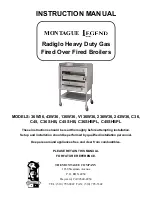
INSTALLER
25
2. Central heating systems
b
Do not use automatic filling devices to add water to central heating systems. Use a manual device instead and
record top-ups in the system service book.
b
If a system comprises a number of boilers, when that system is first put into service, make sure that all the boilers
function simultaneously or on a short interval rotation basis in order to evenly distribute initial limescale deposits.
b
When you finish installing a system, always flush it out to remove installation residues.
b
Water used to fill a system for the first time and water used to top it up must always be filtered (using synthetic or
metal mesh filters with a filtration rating of no less than 50 microns) to prevent sludge from forming and triggering
deposit corrosion.
b
Before re-filling an existing system, clean and flush it out thoroughly. Only fill the boiler after the central heating
circuit has been thoroughly flushed out.
2.1 New central heating systems
Initial filling of the system must be performed slowly. In theory, once filled and bled of all air, a heating circuit should not
need topping up.
Systems should also be operated at maximum working temperature the first time they are started up, in order to facilitate
de-aeration. (Gas is not released from the water at low temperatures.)
2.2 Reconditioning old central heating systems
If a boiler has to be replaced, do not refill the entire central heating circuit if the quality of water in it conforms to requi-
rements. If the quality of water fails to conform to requirements, either recondition the old water or separate the water
circuits (water in the boiler circuit must conform to requirements).
3. Corrosion
3.1 Deposit corrosion
Deposit corrosion is an electro-chemical phenomenon caused by the presence of foreign bodies (sand, rust, etc.) in the
water mass. These solid substances generally form deposits (sludge) in the bottom of the boiler, in the tube heads and
in the joins of tube bundles.
These parts of the boiler can therefore be affected by micro-corrosion caused by the electrochemical potential difference
created between the metal parts in contact with impurities and other metal parts around them.
3.2 Stray current corrosion
Stray current corrosion is caused by the different electrical potentials of the water in the boiler and the metal body of the
boiler or piping. Stray current corrosion is easily identified by the regular tiny conical holes it leaves.
b
All metallic parts should be grounded by an efficient earth cable for this reason.
4. Eliminating air and gas from central heating systems
If oxygen enters a circuit continuously or even intermittently (e.g. in under-floor heating systems whose pipes are not
protected by impermeable synthetic sheaths, in circuits with open expansion vessels, or in circuits that require frequent
top-ups) always separate the boiler’s water circuit from the central heating circuit.
Mistakes to avoid and precautions
From what has been said above we can see that it is essential to avoid two main factors that could lead to corrosion.
















































